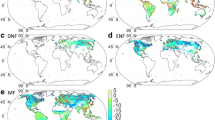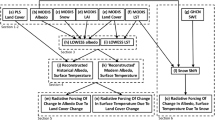Abstract
The impact of man and animal on the Earth's surface albedo (reflectivity), until recently believed to be quite small, or not considered at all, is analyzed. Discussion is presented of changes in the albedo due to the heat island effects of cities on snow cover, to agricultural cultivation, irrigation, and to overgrazing; the latter of which is emphasized. In arid climates, protected steppe areas have a low albedo due to dark plant debris accumulating on the crusted soil surface, whereas the same type of terrain, when overgrazed, exhibits a high albedo of trampled, crumbled soil. Extrapolating from observed spatial differences between overgrazed terrain and natural steppe, it is suggested that anthropogenic pressures mainly due to overgrazing could have had a very significant effect on the Earth's surface albedo both regionally and as a global average during the last few thousand years. The Earth's surface albedo presently might be 0.154 whereas it might have been 0.141 about 6000 years B.P. Thus, the surface albedo could have increased by Δa = 0.013, or by nearly 10% of its value when steppe areas were in their ‘virgin’ state. The hypothesized increase would be much larger in the Northern hemisphere than in the Southern. There are uncertainties even in the second digit of the suggested value for the present day albedo, and thus certainly for the albedo in the past. Seasonal mapping of the surface albedo from LANDSAT type satellites is recommended.
Similar content being viewed by others
References
Amiran, D. H. K.: 1966, ‘Man in Arid Lands: Endemic Cultures’, inArid Lands, E. S. Hills (ed.), Methuen and UNESCO, 219–257.
Bryson, R. A. and Baerreis, D. A.: 1967, ‘Possibilities of Major Climatic Modification and Their Implications: Northwest India, a Case for Study’,Bull. Amer. Meteorol. Soc. 48 (No. 3), 136–142.
Budyko, M. I.: 1974,Climate and Life, Academic Press.
Butzer, K. W.: 1966, ‘Climatic Changes in the Arid Zones of Africa in World Climate from 8000 to 0 B.C.’, Royal Meteorological Society, London, 72–82.
Butzer, K. W. and Twidale, C. R.: 1966, ‘Deserts in the Past’, inArid Lands, E. S. Hills (ed.), Methuen and UNESCO.
Campbell, W. J. and Martin, S.: 1973, ‘Oil and Ice in the Arctic Ocean: Possible Large-Scale Interaction’,Science 181, 56–58.
Charney, J. G.: 1975, ‘Dynamics of Deserts and Draught in the Sahel’,Quart. J. Meteorol. Soc. 101, 193–202.
CLIMAP Project Members: 1976, ‘The Surface of the Ice-Age Earth’,Science 191, 1131–1137.
Colwell, J. E.: 1974, ‘Vegetation Canopy Mapping’,Remote Sensing of Environment 3, 175–183.
Coulson, K. K., Bouricius, G. M., and Gray, E. L.: 1965, ‘Optical Reflection Properties of Natural Surfaces’,J. Geophys. Res. 70, 4601.
Curtis, J. T.: 1956, ‘The Modification of Mid-Latitude Grasslands and Forests by Man’, inMan's Role in Changing the Face of the Earth, W. L. Thomas Jr. (ed.), The University of Chicago Press, 721–736.
Dan, J.: 1973, ‘Pedological Evidences for Climatic Change in Israel During the Pleistocene, in Climatic Variations and Botanical History of Israel’, Department of Botany, Tel-Aviv University, IV–VI.
Duggin, M. J.: 1975, CSIRO, Australia, Personal communication.
Duggin, M. J., Curtain, C. C., Anderson, N., and Yuan, C., 1975, ‘Factors Controlling the Application in Agriculture of Multichannel Remote Sensing Surveys in the Particular Reference to the ERTS Bandpasses’, Proceedings, Fourth Annual Symposium on Remote Sensing of Earth Resources, Tallahoma, Tenn.
Ehrlich, P. R. and Ehrlich, A. H.: 1972,Population, Resources, Environment, Issues in Human Ecology, W. H. Freeman, San Francisco, 509 pp.
Flohn, H.: 1974, ‘Polar Albedo Changes and Their Climatic Consequences’, inApproaches to Earth Survey Problems through Use of Space Techniques, Akademie-Verlag, Berlin, pp. 165–167.
Flohn, H.: 1975, ‘History and Intransitivity of Climate’, in thePhysical Basis of Climate and Climate Modelling’, GARP Publications Series No. 16, ICSU-WMO, pp. 106–118.
GARP JOC: 1975, ‘The Physical Basis of Climate and Climate Modelling’, GARP Publications Series, No. 16, ICSU-WMO, 265 pp.
Gates, D. M.: 1970, ‘Physical and Physiological Properties of Plants’, inRemote Sensing with Special Reference to Agriculture and Forestry, Natural Academy of Sciences, Washington, D.C., pp. 224–252.
Gophna, R.: 1973, ‘Fluctuations in Distributions of Settlements During the Chalcolithic, Early and Middle Bronze Ages as Evidence of Climatic Changes in the Northern Negev’, inClimatic Variations and Botanical History of Israel, Department of Botany, Tel-Aviv University, pp. XII–XIII.
Horowitz, A.: 1973, ‘Palynological Diagrams and Climatic Variations During the Holocene’, inClimatic Variations and Botanical History of Israel, Department of Botany, Tel-Aviv University, pp. VI–VII.
Horowitz, A.: 1976, Tel-Aviv University, Personal communication.
Hovis, W. A., Jr.: 1966, ‘Infrared Spectral Reflectances of Some Common Minerals’,Applied Optics 5, 245–248.
Howard, J.: 1971, Unpublished Report, FAO, Rome.
Huzayyin, S.: 1956, ‘Changes in Climate, Vegetation and Human Adjustment in the Saharo-Arabian Belt, with Special Reference to Africa’, inMan's Role in Changing the Face of the Earth, University of Chicago Press, pp. 304–323.
Jackson, M. L., Gillette, D. A., Danielsen, E. F., Blifford, J. H., Bryson, R. A., and Syers, J. K.: 1973, ‘Global Dustfall During the Quarternary as Related to Environments’,Soil Sci. 116, 135–145.
Jacobwitz, H.: 1976, NOAA/NESS, Suitland, Md., Personal communication.
Jones, B. B.: 1972 (ed.),Oxford Economic Atlas of the World, Oxford University Press.
Kondratyev, K. Ya: 1969,Radiation in the Atmosphere, Academic Press, New York, 912 pp.
Kondratyev, K. Ya, Dyachenko, L. N., and Piatovskaya, M. P.: 1974, ‘On the Relationship Between the Earth-Atmosphere System Albedo and the Earth's Surface Albedo’, inEarth Survey Problems, Akdemie-Verlag Berlin, pp. 473–482.
Kukla, G. J. and Kukla, H. J.: 1974, ‘Increased Surface Albedo in the Northern Hemisphere’,Science 183, 709–714.
Kung, E. C., Bryson, R. A., and Lenshow, D. H.: 1964, ‘Study of a Continental Surface Albedo on the Basis of Flight Measurements and Structure of the Earth's Surface Cover over North America’,Monthly Weather Rev. 92, 543–564.
Lowman, P., Jr.: 1966, ‘The Earth from Orbit’,National Geographic Magazine 130, 645–671
Lowman, P., Jr.: 1971, ‘Geologie Uses of Earth Orbital Photography’, NASA Goddard Space Flight Center Document X-644-71-359.
Marsh, P. G.: 1864,Man and Nature, Physical Geography as Modified by Human Action, C. Scribner, New York.
McLeod, N.: 1976, Personal communication.
Noy-Meir, I.: 1975, The Hebrew University of Jerusalem, Department of Botany, Personal communication.
Otterman, J.: 1973, ‘Preliminary Results from Israeli ERTS-1 Program’,Rassegna Internazionale Elettronica Nucleare ed Aerospaziale XX, Rome, Italy, 199–203.
Otterman, J.: 1974, ‘Baring High-Albedo Soils by Overgrazing, a Hypothesized Desertification Mechanism’,Science 186, 531–533.
Otterman, J. and Fraser, R. S.: 1976, ‘Earth-Atmosphere and Surface Reflectivities in Arid Regions from LANDSAT Multispectral Scanner Measurements’,Remote Sensing of Environment 5, 247–266.
Otterman, J., Waisel, Y., and Rosenberg, E.: 1975, ‘Western Negev and Sinai Ecosystems: Comparative Study of Vegetation, Albedo and Temperatures’,Agro-Ecosystems 2, 47–59.
Otterman, J., Walter, L. S., and Schmugge, T. J.: 1976, ‘Observations from ERTS of Overgrazing and Cultivation Impact on the Earth's Surface’,Space Research XVI, Academie-Verlag, Berlin, pp. 15–21.
Rouse, J. W. Jr., Haas, R. H., Schell, J. A., and Deering, D. W.: 1973, ‘Monitoring Vegetation Systems in the Great Plains with ERTS, Third Earth Resources Technology Satellite-1 Symposium’, NASA SP-351, pp. 309–318.
SCEP: 1970,Man's Impact on the Global Environment, The MIT Press.
SMIC: 1971, ‘Inadvertent Climate Modification’, Report of the Study of Man's Impact on Climate (SMIC), The MIT Press.
Thomas, W. W. Jr. (ed.): 1956,Man's Role in Changing the Face of the Earth, The University of Chicago Press, 1193 pp.
U.S. Committee for the GARP: 1975,Understanding Climatic Change, National Academy of Sciences, Washington, D.C.
Vinogradov, B.: 14.969, ‘Remote Sensing of the Arid Zone Vegetation in the Visible Spectrum for Studying the Productivity’, Proc. 6th Int. Symp. Remote Sensing Environ., Univ. of Michigan, pp. 1237–1250.
Yaalon, D. H.: 1975, ‘Rates of Aeolian Dust Accrition in the Mediterranean and Desert Fringe Environments of Israel’,9th International Congress Sedimentology, Vol. 2, pp. 174–196.
Yaalon, D. H.: 1976, Hebrew University, Department of Geology, Jerusalem, Personal communication.
Yaalon, D. H. and Ganor, E.: 1973, ‘The Influence of Dust on Soils During the Quarternary’,Soil Sci. 116, 146–155.
Author information
Authors and Affiliations
Rights and permissions
About this article
Cite this article
Otterman, J. Anthropogenic impact on the albedo of the earth. Climatic Change 1, 137–155 (1977). https://doi.org/10.1007/BF01884408
Received:
Issue Date:
DOI: https://doi.org/10.1007/BF01884408




